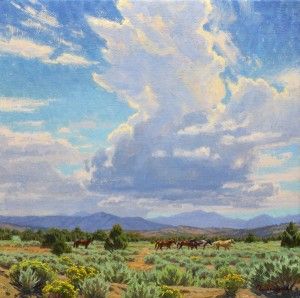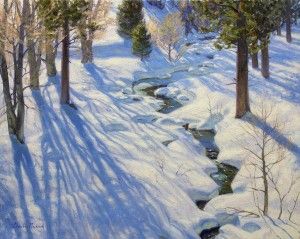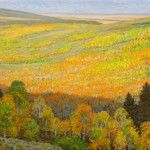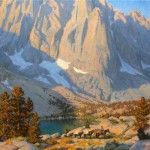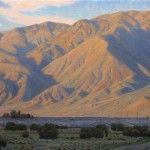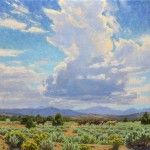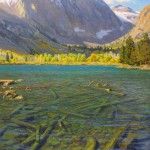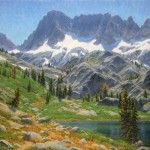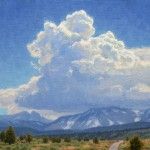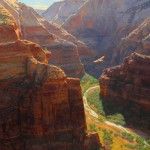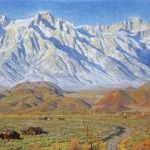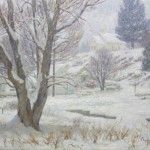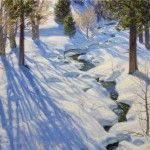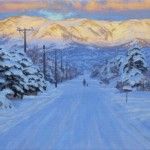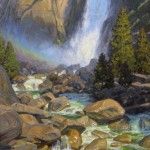Charles Muench | Late Summer Sotrm, oil, 24 x 24.
Communing with nature inspires Charles Muench
By Rosemary Carstens
This story was featured in the April 2013 issue of Southwest Art magazine. Order the Southwest Art April 2013 print issue, or get the Southwest Art April 2013 digital download now…Or better yet, just subscribe to Southwest Art and never miss a story!
CHARLES MUENCH loves the lonely places. It is in the West, under a vast open sky, that the artist finds inspiration for his landscape paintings. “To truly understand the subject of your art,” he declares, “you must immerse yourself in it fully.” And so he does—his home ground is outside the small town of Gardner-ville, NV, with its high desert bordered by the Pine Nut Mountains to the east and the massive Sierras to the west. From here he journeys to favorite spots he revisits regularly throughout the West.
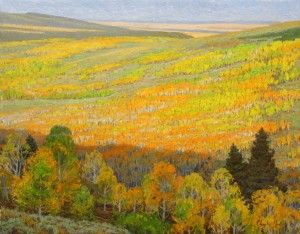
Charles Muench | In a Sea of Autumn, oil, 22 x 28.
“It’s getting out and observing the things that are happening around you that matters—the smell of pine, the crunch of snow beneath your feet, the cloud that appears seemingly out of nowhere—this is how nature speaks to me,” Muench says. He prefers returning to places again and again, in every season and at different times of day, coming to know them intimately, as you might come to know a lifelong friend. For him, a deeper relationship with his subject matter entails a conversation, one in which he listens to the silence, absorbs its wisdom, and carries it home to his studio to portray on canvas.
Muench paints outdoors, too. He’s frequently drawn to gothic, monolithic shapes and the challenges of bringing their magnificence to life in his art, and to discovering each region’s unique, often mysterious, personality. He finds the western Sierra “more welcoming, with its rounded granite shapes and blanketed expanses of pine. It seems to say, ‘Hey, let’s talk,’ while the eastern Sierra, with its crags, tarns, and jagged peaks, appears more menacing, more ‘Leave now, before I get angry!’”
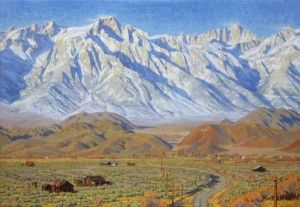
Charles Muench | The New, the Old, and the Ancient, oil, 28 x 40.
GROWING UP in California, Muench has always had an interest in the outdoors. First introduced to the Sierras on fishing trips, at the age of 17 he backpacked to lakes above timberline where nature gave him, as he puts it, “a real ass-kicking.” He was ill prepared for the backcountry’s harshness and, like a Marine Corp drill sergeant, it quickly taught him respect. Years of wilderness experiences have pounded home necessary outdoor survival skills, and he has become comfortable in all kinds of terrain and weather.
From an early age Muench knew he wanted a fine-art career. Humanities and philosophy teachers in his public high school also opened his mind to the Renaissance ideal of a well-rounded education. “Most good painters I meet,” he notes, “have a general curiosity about life that goes far beyond pigment and canvas.”
During his college years at San José State University, Muench studied with one of his most important mentors, Maynard Dixon Stewart. “He set me on the course to where I am today,” Muench says. “I still visit him. In early February of this year he celebrated his 90th birthday; I brought him a gift of my own venison summer sausage, and we talked about, what else, art! Stewart instilled in me the idea of ‘rationalizing your sight,’ striving to understand what you are painting. Don’t just mindlessly copy—make decisions, improve upon nature.”
Charles Muench | Winter Shadows, oil, 24 x 30.
“If you only relate to a cloud as a place to store your tunes, you are missing out on the richness of existence.”
Muench graduated with a bachelor of fine arts in 1988, then attended the Art Students League of New York before moving on to live and work in Spain for a year and a half. In Madrid, he attended figurative classes, spent long hours copying masters’ works at the Prado, and began grappling with the challenges of painting outdoors, particularly street scenes and small towns. Muench returned from Spain determined to make his way as a full-time fine-art painter. Back in San José, CA, he lined up galley representation, began selling, and devoted himself to refining his skills.
Paul and Susan Bingham, founders of the Thunderbird Foundation for the Arts, which is responsible for preserving the Maynard Dixon property in Utah and hosting the Maynard Dixon Country annual art show, met Muench when he was fresh out of the Art Students League, and they were immediately impressed with his work. “From the beginning, Charles showed incredible talent,” says Susan. “He has transformed himself into an accomplished landscape painter, filling his paintings with exquisite color and light that are based on sound principles of drawing, design, composition, perspective, and, most importantly, a style that is all his own. It has been a joy to watch this very fine artist become a notch above so many others.”
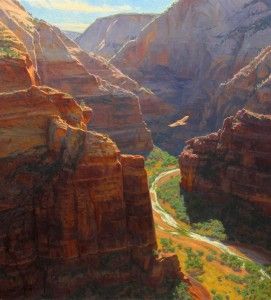
Charles Muench | Soaring, oil, 40 x 36.
BUT THERE is more to Charles Muench than art. In 2012, he wrote and published Markleeville Memories: Paintings of a Sierra Town, a small, elegant volume filled with entertaining tales of his eight years in a small eastern Sierra town, illustrated with 41 of his paintings. Other passions include cooking, gardening, and, perhaps most of all, hunting. “Putting down the brushes for the thunder stick in pursuit of gray ghosts of autumn informs my art a great deal. It finds me once again seeking remote places for sustenance, both physical and emotional.”
It was just such a hunting trip that inspired IN A SEA OF AUTUMN. His quest had taken him to northeastern Nevada’s Jarbidge Wilderness area—64,667 acres of spectacularly rugged terrain featuring 10 peaks over 10,000 feet. One of the least-visited wilderness areas, it is home to abundant wildlife. As he set up camp, Muench was struck by the luminescence of rolling hills filled with undulating fall color and the feeling of unlimited open space. “Hunting takes you to places you might not otherwise have gone. When I returned to the studio, the biggest challenge was how to convey the exuberance and emotion of autumn in a setting without the usual anchors of mountains, creeks, or boulders,” Muench says. “I used the detailed trees in the offset foreground as a key design element to set the scene and draw the viewer in, to allow him to understand the sea of color beyond them. The exceptionally high horizon line helps to emphasize the immensity of the scene.”
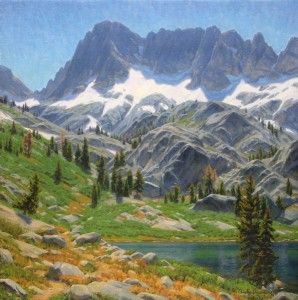
Charles Muench | Sierra Classic, oil, 40 x 40.
Muench’s paintings speak to us of nature’s diversity, from regal mountain peaks to the more tranquil beauty of forest and stream to wintry images evoking the season’s hush and icy chill. Moreover, his work shares his deep, emotional response to nature. “Landscape painting serves as a reminder of the importance of nature, open spaces, and a healthy environment,” Muench says. “It also helps people see their natural world, opens their eyes to its incredible beauty. If you only relate to a cloud as a place to store your tunes, you are missing out on the richness of existence.”
A close examination of IN A SEA OF AUTUMN or SIERRA CLASSIC—with its massive peaks looming over a serene alpine lake—reveals the depth of Muench’s talent. “I like a lot going on,” he says. From a preliminary drawing of washes and lines, he creates an underpainting—often in colors complementary to what he envisions as final hues—to establish masses, texture, and shapes. Working on five paintings at a time, he moves from one to the next in stages. This allows him a fresh perspective when he returns to the first painting in the sequence. His works are frequently quite large, appropriately so for the expansive character of his subject matter. As he works, he tries to project what will happen to areas of the painting as he lays on subsequent layers. Thick and thin, textured and smooth, palette knife and brush, glazing here and there for emphasis—all are key components in a Muench painting.
Irvine Museum founder Joan Irvine Smith and the museum’s president, James Irvine Swinden, have each amassed private collections that are among the largest and most complete collections of historic and contemporary California paintings in the United States. Muench figures prominently in them. “Muench won the Irvine Museum Gold Medal in the 2012 California Art Club Gold Medal Exhibition,” says Jean Stern, executive director of the museum, “because the painting he entered was such an outstanding example of great art created in the manner and spirit of the historical American plein-air painters. I have long admired his work. He braves the most inhospitable situations to get the light as true as possible … certainly the most difficult goal of landscape painting. Few artists are capable of doing it perfectly, and Charles is in that elite group.”
Muench takes nothing for granted. He is keenly aware of what it takes for an artist to succeed: “ambition, ego, and an elephant hide tough enough to repel despair, failure, and criticism,” he says. Continuing in his often colorful descriptive style, he compares success in hard economic times to four-wheeling along a muddy road: “You have to gun the accelerator just to keep from sliding into the ditch, but once the road clears and the wheels catch traction, I think it’s going to get really interesting!”
representation
Josh Hardy Galleries, Carmel, CA; Galerie Gabrie, Pasadena, CA; Williams Fine Art, Salt Lake City, UT; Bingham Gallery, Mount Carmel, UT; Knowlton Gallery, Lodi, CA; www.charlesmuench.com.
- Charles Muench | In a Sea of Autumn, oil, 22 x 28.
- Charles Muench | In the Land of Giants, oil, 32 x 36.
- Charles Muench | Inyo Mountains Sunset, oil, 20 x 32.
- Charles Muench | Late Summer Sotrm, oil, 24 x 24.
- Charles Muench | Parker Lake Waters, oil, 40 x 36.
- Charles Muench | Sierra Classic, oil, 40 x 40.
- Charles Muench | Sierra Summer Storm, oil, 12 x 12.
- Charles Muench | Soaring, oil, 40 x 36.
- Charles Muench | The New, the Old, and the Ancient, oil, 28 x 40.
- Charles Muench | Veiled in Winter, oil, 24 x 30.
- Charles Muench | Winter Shadows, oil, 24 x 30.
- Charles Muench | Winter Tranquility, oil, 16 x 26.
- Charles Muench | Yosemite Falls, oil, 30 x 24.
MORE RESOURCES FOR ART COLLECTORS & ENTHUSIASTS
• Subscribe to Southwest Art magazine
• Learn how to paint & how to draw with downloads, books, videos & more from North Light Shop
• Sign up for your Southwest Art email newsletter & download a FREE ebook






